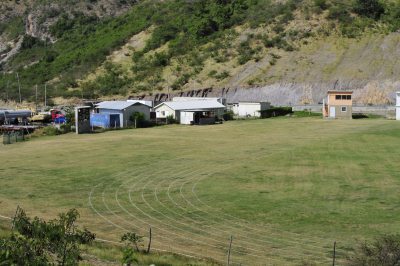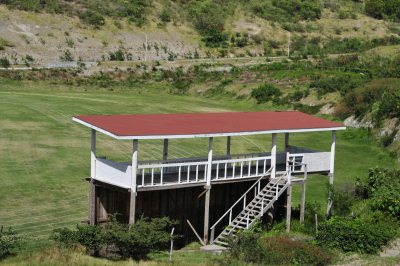Montserrat

|
Montserrat
 Montserrat is a British overseas territory located in the Leeward Islands, part of the chain of islands called the Lesser Antilles in the Caribbean Sea. The island is nicknamed the Emerald Isle of the Caribbean, both for its resemblance to coastal Ireland and for the Irish descent of its inhabitants.

History: Montserrat was populated by Arawak and Carib people when it was claimed by Christopher Columbus on his second voyage in 1493, naming the island Santa Maria de Montserrate, after the Blessed Virgin of the Monastery of Montserrat. The island fell under English control in 1631 when a group of Irish suffering anti-Catholic violence in St Kitts and Nevis, many of whom had been forcibly removed from Ireland as indentured servants, settled there. More Irish settlers arrived after Oliver Cromwell's defeat at the Battle of Drogheda in 1649, when Irish political prisoners were transported to Montserrat. Place names and surnames such as Dublin, Daley, Corbett, Galloway, O'Brien, O'Garro, Riley, White and Ryan are commonly found. Ireland is represented in the country's flag by the harpist maiden wearing green and holding a cross. The
import of African slaves,
common to most Caribbean islands, began early. An economy based on sugar,
rum,
arrowroot
and Sea
Island cotton
was established. By the late 1700's there were many plantations on the
island. In
1782, during the American
Revolutionary War, Montserrat was briefly captured by France.
It was returned to the United Kingdom under the Treaty
of Paris which ended that conflict. A failed slave uprising on the
17th of March 1798 led to Montserrat becoming one of only four places in
the world that celebrates St
Patrick's Day as a public holiday (the others being the
Republic of Ireland, Northern
Ireland and the Canadian
province of Newfoundland
and Labrador). Slavery was abolished in Montserrat in
1834. Falling
sugar prices during the nineteenth century had an adverse effect on the island's
economy and in 1869 the philanthropist Joseph
Sturge of Birmingham, England formed the Montserrat Company to buy
sugar estates that were no longer economically viable. The company planted limes
starting production of the lime juice, set up a school, and sold parcels of land
to the inhabitants of the island, with the result that much of Montserrat came
to be owned by smallholders. From 1871 to 1958 Montserrat was administered as part of the Federal Colony of the Leeward Islands, becoming a province of the short-lived West Indies Federation from 1958 to 1962. In 1979 George Martin’s AIR Studios Montserrat opened and the island attracted world-famous musicians who came to record in the peace and quiet and lush tropical surroundings of Montserrat.
 
The pictures above were once advertising for tourists, the river has gone so has the waterfall.
The last decade of the 20th century, however, brought two events which devastated the island. On the 17th of September 1989, the Category 5 Hurricane Hugo struck Montserrat with sustained winds of 160 miles per hour, damaging over 90 percent of the structures on the island. AIR Studios closed, and the tourist trade upon which the island depended was nearly wiped out. Within a few years, however, the island had recovered considerably - only to be struck again by disaster. In July 1995, Montserrat's Soufriere Hills volcano, dormant throughout recorded history, rumbled to life and began an eruption which eventually buried the island's capital, Plymouth, in more than thirty nine feet of mud, destroyed its airport and docking facilities, and rendered the southern half of the island uninhabitable. Following the destruction of Plymouth, more than half of the population left the island due to the economic disruption and lack of housing. The ash venting does occasionally extend into the populated areas of the northern and western parts of the island.
 
Stark reminders
The southern part of the island has been evacuated and visits are severely restricted. Since volcanic activity began, the human population on the island has declined from approximately 11,000 to about 4,500. A sustainable development plan has been developed for Montserrat and it will be important to integrate environmental aspects into the island’s redevelopment. Today most of Montserrat remains lush and green. A new airport at Geralds in the north (renamed the John A. Osborne International Airport in 2008) was opened officially by Princess Anne, the Princess Royal in February 2005, and received its first commercial flights on the 11th of July 2005. Docking facilities are in place at Little Bay, where the new capital is being constructed. The people of Montserrat were granted full residency rights in the United Kingdom in 1998 and citizenship was granted in 2002.

The symbol of Plymouth - the War Memorial, here it is featured in an edition of the National Geographic, showing the ash fall from early volcanic activity. Sadly now gone, buried completely. Geography: The island of Montserrat is located approximately thirty miles southwest of Antigua. It comprises only forty square miles and is increasing gradually owing to volcanic deposits on the southeast coast of the island; it is ten miles long and seven miles wide, with dramatic rock faced cliffs rising fifty - a hundred feet above the sea and smooth bottomed sandy beaches scattered among coves on the west side of the island. Montserrat has been a quiet haven of extraordinary scenic beauty. Montserrat has two islets: Little Redonda and Virgin, and Statue Rock.

The nearly finished food market Economy: Since the twin devastations of Hurricane Hugo and the eruption of the Soufriere Hills Volcano, the Montserratian economy has been effectively halted. Export businesses currently based in Montserrat deal primarily in the selling and shipping of aggregate for construction. Imports include virtually everything available for sale on the island. The island's operating budget is largely supplied by the British Government and administered through DFID (the Department for International Development) amounting to approximately £25 million per year. Additional amounts are secured through income and property taxes, license and other fees as well as customs duties levied on imported goods. A short distance from the Cultural Centre is the two storey food market, costing US $630,000, the ground floor is complete. The $8.5 million first phase of Little Bay infrastructure project is in progress.  
The cricket pitch proudly overlooks Little Bay and is also used by the local schools as a sports ground
Famous
Montserratians: Jim
Allen - former cricketer who represented the World
Series Cricket West Indians. Lionel
Baker - the first Montserratian to represent the West Indies in
international cricket. Alphonsus
"Arrow" Cassell MBE
— well known for his soca
song "Hot
Hot Hot" which has sold over four million copies. Maizie
Williams - musician, member of musical group Boney
M.
Culture: Cricket is a popular sport in Montserrat. Players from Montserrat are in fact eligible to play for the West Indies cricket team. Jim Allen was the first to play for West Indies and he represented the World Series Cricket West Indians. No other player from Montserrat had gone on to represent West Indies until Lionel Baker made his One Day International debut against Pakistan in November 2008. Montserrat has its own FIFA Affiliated Football Team, and has twice competed in the World Cup qualifiers.

Flora and Fauna: Despite its small size, Montserrat supported at least one hundred and thirty two tree species, fifty nine species of birds and thirteen mammals. The Montserrat oriole is found nowhere else. Also restricted to Montserrat are the galliwasp and another unnamed lizard. The endangered and edible 'mountain chicken' (a frog) is found only on Montserrat and Dominica. There is a rare fruit bat found in the caves between Little bay and Rendezvous Bay. Several other species are restricted to Montserrat and some nearby islands. The effects of the eruptions on the island's plants and animals are being studied where circumstances allow. Extensive monitoring of the Montserrat oriole - the National Bird - the mountain chicken and other important key indicator species, is ongoing. It is however the first Caribbean island we have visited where we have seen NO Carib Grackle. In fact our tally is four brown boobies, three frigate birds, two pelicans, four doves and a few chickens. You hear no birdsong and see few wild flowers other than planted in gardens and a few tough survivors on the edges of Plymouth. We will be interested to see how, when and if visiting birds come back to stay and if the natives survive. Acid rain, islands nearby with no threats are great deciders.
ALL IN ALL OUR HEARTS GO OUT TO MONTSERRAT AND HER HAPPY PEOPLE SO PLEASED TO HAVE BEEN ABLE TO VISIT
|